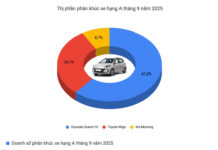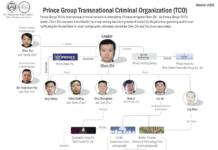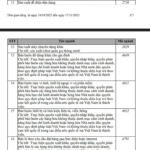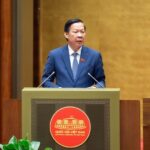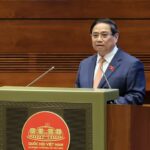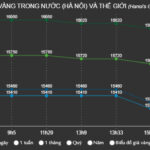The Central Executive Committee has just released the full draft of documents to be presented at the 14th National Congress, seeking public input. Notably, the Political Report has been crafted with a fresh approach, integrating the contents of both the Socio-Economic Report and the Party Building Summary Report.
For the first time in the history of the Congress, the entire national development strategy—ranging from political guidelines and socio-economic strategies to Party building—is presented within a single document. This consolidation reflects a commitment to unifying three critical pillars: institutions, the economy, and the people. It aims to bridge the gaps between political directives, development plans, and their execution within the system.
The draft reviews 40 years of renovation, acknowledging Vietnam’s achievements as “significant, comprehensive, breakthrough, and marked by numerous highlights.” For the 2021-2025 period, the average GDP growth is projected at 6.3% annually, with the economy reaching over $510 billion and per capita income hitting approximately $5,000, propelling Vietnam into the upper-middle-income country group. Notable advancements are expected in infrastructure, industry, services, living standards, defense, and foreign relations.
However, the draft also highlights challenges such as overlapping institutions, growth below potential, low technological capacity, insufficient innovation as a primary driver, and increasing social disparities.
In response, the document outlines that the 2026-2030 period must mark a pivotal shift toward a new growth model, emphasizing flexible institutions, a green economy, and creative human resources as the foundation for a self-reliant and developed society.
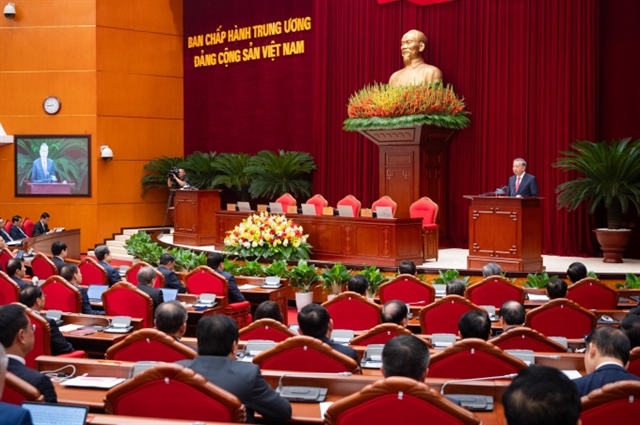 General Secretary To Lam speaks at the 13th Central Committee Conference. Photo: VGP/Nhat Bac |
One Document, Three Pillars
The consolidation of the Political Report, Socio-Economic Report, and Party Building Report into a single document marks a strategic shift in governance. Previously separate, these three domains are now viewed as an integrated whole, where political guidelines provide direction, the economy drives momentum, and the people remain at the core and ultimate goal.
The document clearly outlines three development phases: by 2030, Vietnam aims to become a modern industrialized nation with upper-middle-income status; by 2045, it seeks to achieve developed country status with high income; and by 2050, it envisions a prosperous, civilized, and happy society. Specific targets include an average GDP growth rate of 10% annually from 2026 to 2030, an 8.5% increase in labor productivity, a total factor productivity contribution of over 55%, a digital economy share of 30% of GDP, urbanization exceeding 50%, and an 8-9% reduction in greenhouse gas emissions.
Three strategic breakthroughs have been restructured for a more comprehensive approach. First, institutional refinement will lay the groundwork for rapid and sustainable development. Concurrently, Vietnam will focus on developing a high-quality workforce aligned with science and technology, recognizing this as crucial for economic competitiveness. The third breakthrough involves synchronized investment in socio-economic infrastructure, prioritizing digital infrastructure, energy, strategic transportation, and green urban development.
The draft also proposes a comprehensive revision of the 2013 Constitution to enhance the socialist rule of law, promote decentralization, and establish more flexible and efficient operational mechanisms. The goal is to create a seamless institutional environment that unlocks the nation’s full development potential.
These directives reflect a new leadership mindset, prioritizing institutions as the foundation, science and technology as the driving force, people as the central focus, and culture as the root of development.
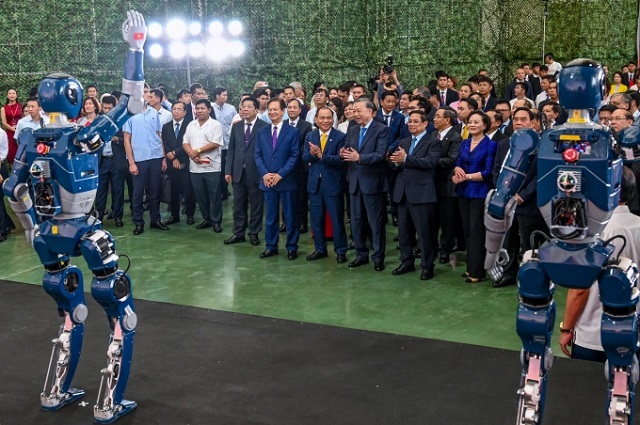 Party and State leaders observe a humanoid robot demonstration at an August exhibition. Photo: Giang Huy
|
Science and Technology: The Core Driver of New Growth
For the first time, science, technology, and innovation are positioned at the heart of the growth model. The document emphasizes that “developing science and technology is a breakthrough task and a prerequisite for Vietnam’s transition to a knowledge-based economy.”
The draft calls for the refinement of mechanisms and policies to support research, development, and application, ensuring autonomy and international competitiveness. Priority areas include artificial intelligence, semiconductors, biotechnology, new materials, clean energy, quantum technology, space exploration, and peaceful nuclear energy. Vietnam plans to establish a national data center, develop a chip industry, foster a global innovation network, and encourage overseas Vietnamese experts and private enterprises to invest in new technologies.
Simultaneously, a comprehensive shift toward a digital economy, green economy, and circular economy is underway. By 2030, these sectors are targeted to contribute 30% of GDP. Additionally, the document introduces the concept of “technological sovereignty,” reflecting the nation’s ambition for self-reliance in strategic sectors, viewing core technology mastery as a pillar of national strength.
The integration of science, technology, and the economy introduces a new approach: moving beyond mere application to creation. Previously seen as a tool for production support, technology is now recognized as the foundation for a new growth model, where knowledge and innovation generate the highest value-added.
 Students at Bui Van Moi Primary School, Phuoc Long Ward, September 2025. Photo: Quynh Tran |
People: The Core of Sustainable Development
Within the document’s overarching framework, people are positioned at the center, serving as both the goal and driving force of all policies. Vietnam has established “four value systems”—national, cultural, familial, and individual—as the spiritual foundation for the new development era, measuring the state’s success by the happiness and satisfaction of its citizens.
Education is identified as the nation’s top priority, pivotal to the future of the Vietnamese people. The document aims to build a modern, equitable, and internationally integrated national education system, implementing a national program for education modernization. Public education will serve as the cornerstone, with non-public education playing a significant role.
Vietnam will integrate digital literacy (AI) into the primary curriculum, gradually establish English as a second language, and develop select research-oriented universities into regional science and innovation hubs. Special incentives will be provided for educators, scientists, and education administrators.
Alongside education, a strategy for developing a high-quality workforce is in place. Vietnam will actively engage in international education integration, attract talent and experts from abroad, foster a lifelong learning society, and recognize knowledge as the most valuable social asset.
In healthcare, the document aims for an equitable, efficient, and sustainable system, ensuring regular health check-ups for all citizens, progressing toward free basic healthcare and universal insurance coverage. A multi-tiered social welfare policy will be implemented to ensure no one is left behind. By 2030, the goal is to eliminate poverty, achieve a life expectancy of 75.5 years, and ensure 68 years of healthy living.
Culture and society are affirmed as the spiritual foundation of development. For the first time, the Political Report introduces the concepts of “national value systems, cultural value systems, family value systems, and Vietnamese human standards,” marking a shift in understanding: development is not just about growth but also about elevating humanity. Culture is no longer peripheral but a core driver of development. Vietnam will advance the cultural industry, preserve heritage, encourage artistic creativity, promote gender equality, and ensure religious freedom and cultural diversity.
At a higher level, the document emphasizes strengthening national defense and security, expanding comprehensive, independent, peaceful, and cooperative foreign relations. The defense industry will be developed with dual-use capabilities, and the armed forces will be built as elite, professional, and closely connected to the people. Vietnam will continue to play a proactive role in regional mechanisms, enhancing technology diplomacy, environmental diplomacy, and people-to-people diplomacy.
Party building is considered the key to all keys. The cadre system will operate on the principle of “entry and exit, promotion and demotion,” protecting those who dare to think, act, and take responsibility. Mechanisms will be perfected to prevent corruption through inability, unwillingness, or lack of opportunity. This forms the political foundation for all developmental breakthroughs.
The consolidation of three documents, the restructuring of three strategic breakthroughs, the central role of science and technology, and the focus on people as the core have shaped Vietnam’s long-term vision. It aspires to be a modern, creative, humane, self-reliant, and happy nation.
Vu Tuan
– 05:00 21/10/2025
Samsung Expands Smart Home Robot Production in Ho Chi Minh City
Samsung Electronics Home Appliances Complex (SEHC), a 70-hectare, $1.4 billion investment, broke ground in Ho Chi Minh City in May 2015. Initially focused on premium TVs, including SUHD TV, Smart TV, and LED TV, this state-of-the-art facility marks a significant milestone in Samsung’s global manufacturing footprint.
SHB Reports 36% Surge in Pre-Tax Profit for Q1-Q3, Bolstering Financial Strength
Saigon-Hanoi Commercial Joint Stock Bank (SHB) continues its robust growth trajectory, reporting a pre-tax profit of VND 12,307 billion for the first nine months of 2025. This impressive figure marks a 36% year-on-year increase and represents 85% of the bank’s annual target.
Vietnam’s Prime Minister: Economy Demonstrates Resilience Against External Shocks, Leading Global Growth
At the opening session of the 10th Meeting of the 15th National Assembly, Prime Minister Pham Minh Chinh highlighted eight remarkable achievements in the implementation of the Socio-Economic Development Plan for 2025 and the five-year period 2021–2025. Notably, Vietnam’s economy has demonstrated robust resilience against external shocks, sustaining one of the highest growth rates globally. The country’s economic scale has surged, climbing five positions to rank 32nd worldwide.





